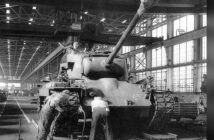Where did Genesee County inhabitants come from? Where did they settle once they arrived? For Part 2 of our series, let’s explore the immigration and settlement patterns of early Genesee County.
In The Book of the Golden Jubilee, W.R. Bates quotes the Michigan Gazetteer, which was written about Flint and published in 1838: “The emigration to this place has been very great the past two years, and still continues. The village is flourishing, and the country around it excellent. It is estimated to contain three hundred families.” This is not the only commentary on the growing population, but it does sum up how desirable the county was at the time, not only to American citizens to keep moving west, but also people from around the world, which contributed to Genesee County’s diverse population.
According to Dr. Robert Shafer’s 1989 book, Producing a Human Mosaic: Immigration and Economic Change in the Development of Genesee County’s Population, most of Michigan’s foreign-born residents resided in Genesee County. For economic stimulation, many prominent governmental figures in the area encouraged foreign emigration direct to Michigan from Europe. The county was made up of very “diverse strands,” which did include early Native Americans.
The 1820 U.S. Census listed fewer than 10,000 settlers in the Michigan territory, most living in or near Detroit, and at the time, that territory included present-day Wisconsin and Minnesota. Of those 10,000 settlers, most were of French and Canadian descent. Shortly after Michigan became a state in 1837, a settler observed that the “tide” of emigration was “rapidly increasing,” most traveling from New England and upstate New York. In 1836, there were 2,800 residents in present-day Genesee County, coming from New York’s Genesee Valley.
Most residents lived near the Flint River, spreading out on both sides of the Saginaw Trail. This provided an epicenter for the social, political and economic life of the time. This epicenter continued to help attract new settlers into the area, even if residents preferred to live out in the rural areas; it gave them the opportunity to visit a “civilized” area to sustain relationships and trade.
Listed in the 1840 census, 4,269 people were scattered through several different townships: Flint, Grand Blanc, Fenton, Flushing, Genesee, and others. Of that number, 2,299 were white males, 1,961 were white females, four were black males, and five were black females. By 1850, the total population rose to 12,301; 1,061 (9%) had been born outside of the United States. It was recorded that 1,061 were British immigrants, 66 were German, 13 were French, three from Spain, and one each from Belgium, Switzerland, Portugal, Poland, and Brazil.
In the 1850s, the Germans were the largest immigration group in America as a whole with 951,657 arriving in the decade, Irish arriving with 914,119, and English, Scots and Welsh with 423,929. From 1860-1890, more than 700,000 immigrants came to Michigan, and of that group, more than half were from Europe and Canada. Contrary to German predominance in America, in Genesee County, those of German descent were not the largest single group of immigrants. Throughout the 19th century, they arrived in every decade far behind Canadians, Irish and English. About 90 percent of immigrants were British born. From 1850-1900, most people who settled in Genesee County had emigrated from England. Germany came before France in that same time frame.
In Genesee County, the number of inhabitants who were of German descent was much smaller than in the U.S. as a whole. It can be concluded that the settlers who did come to the area presumably “melted” or assimilated easily into the dominant Anglo-American pattern, and had little influence on the local culture, except for individual cases. Another conclusion takes us into the occupations of distinctive groups. The Canadian immigrants, for example, brought certain specialty skills during a crucial shift in the economy, which then led to large-scale lumbering operations that were crucial to Genesee County’s industrial history, and even later, with the development of the carriage industry.
Next month … Part 3: Occupations of Early Settlers. Before the Vehicle City, how did people make a living?













